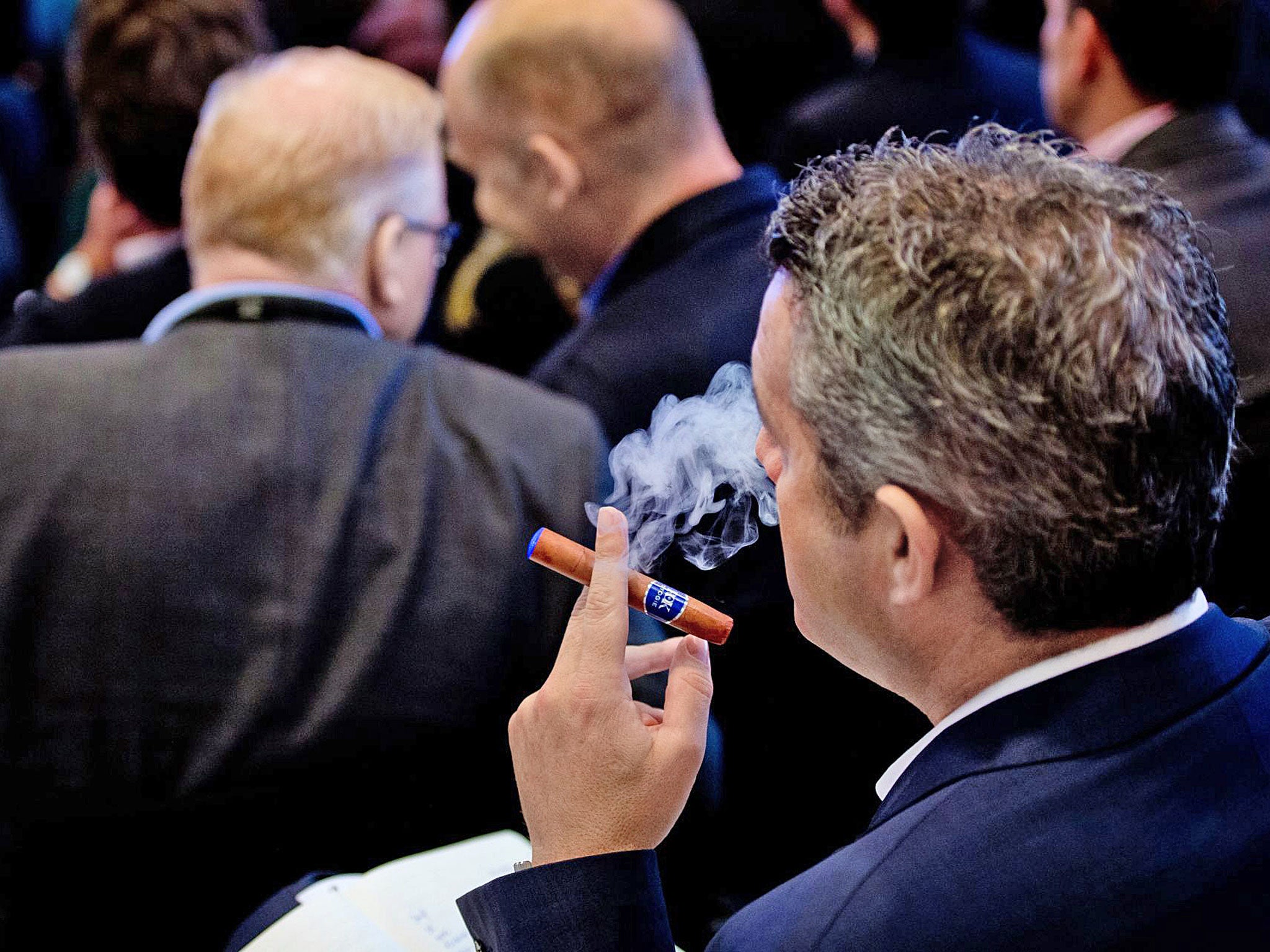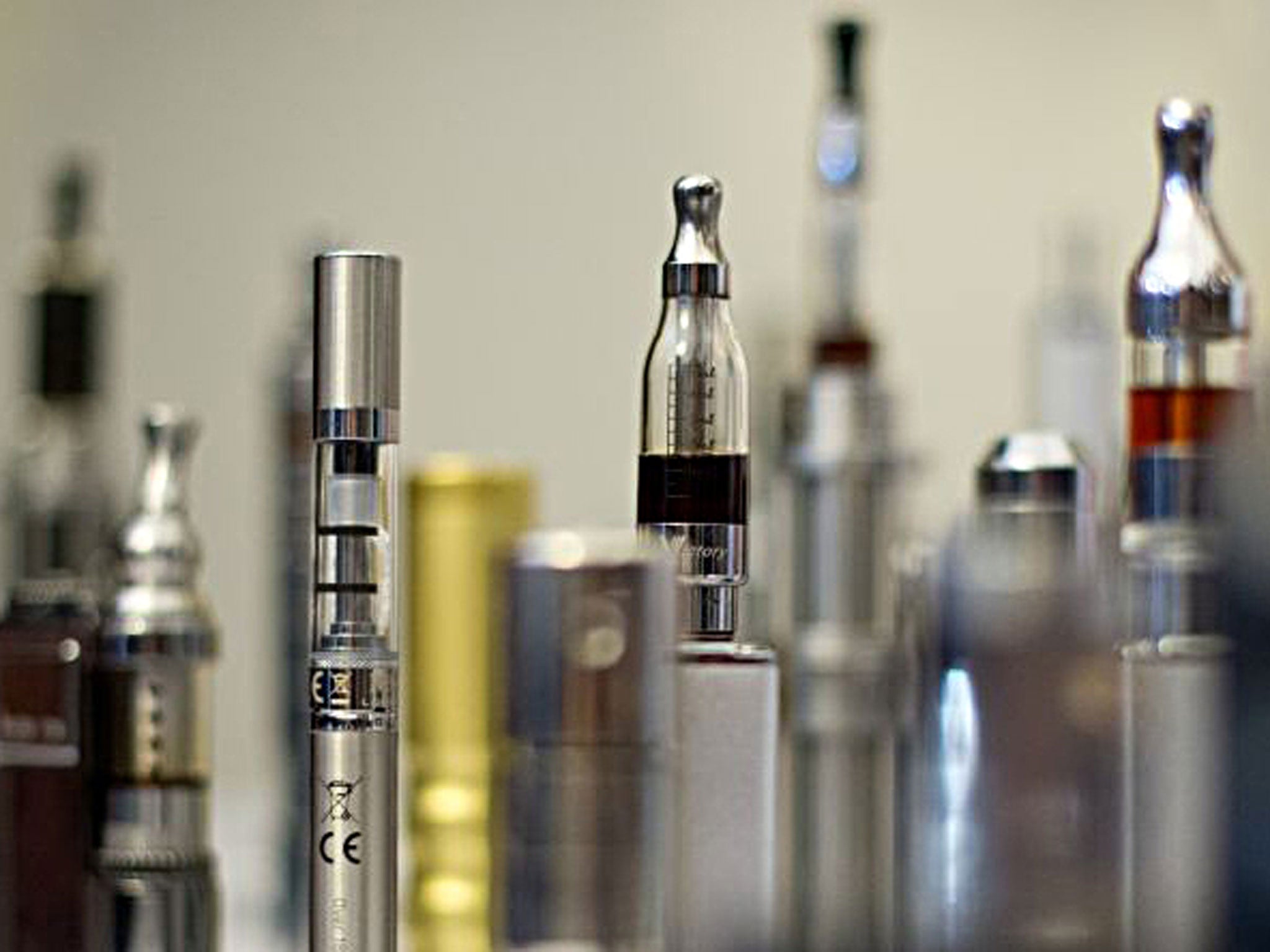No smoke without ire: the e-cigarette revolution
The rise of the faux fag has ignited a debate about when and where it is acceptable to 'light up'

All new behaviours raise complex questions of etiquette. The sudden ubiquity of e-cigarettes – electronic substitutes for the cancer sticks of old – is challenging our assumptions about where it is appropriate to "smoke". More than a million people are using them in the UK and, according to Bloomberg, on present trends they will outsell conventional cigarettes by 2047. So is it OK to "fire up" in an office? In a restaurant? In a hospital bed?
Heathrow has just opened the world's first airport "vaping" zone, sponsored by a manufacturer of the devices, in the Terminal 4 international departure lounge. It stressed that all forms of smoking remained forbidden elsewhere – but the move underscored the need for clarity on the matter. Is "vaping" smoking? Or not? Airlines aren't keen on the practice, not for health reasons but because they fear it could trigger disputes between passengers. Yet there is no law preventing it. One e-cigarette manufacturer, Vapestick, has gone as far as publishing guidance on how to get away with vaping during flights (the vapour is unlikely to set off the smoke alarm in the toilet).
The pace of change is illustrated by the story of the hapless e-cigarette user travelling by coach down the M6 from Preston to London last year who found himself the focus of a full-scale terrorist alert. Passengers on the Megabus noticed smoke coming from his bag and thought they saw him pouring liquid into it. They alerted the driver who made an emergency call, armed police swooped, closing the motorway and causing a tailback that stretched for miles on one of Britain's busiest roads.
Eighteen months on, that incident feels like ancient history. Could anyone mistake an e-cigarette for a bomb today? They are everywhere – touted by street salespeople, promoted on the web, sold from specialist shops and advertised on house-sized posters.
For a product invented in 1963, just as the harm caused by tobacco was starting to become widely known, the recent surge in their popularity has been astonishing. Early versions were unwieldy, delivered an inadequate "hit" of nicotine and suffered from what was unkindly described as a "hernia effect" – users had to suck hard to get anything at all.
Tobacco companies were suspected of trying to undermine the new devices which threatened to encroach on their lucrative markets. If that was so then, it has dramatically changed today. The major companies including British American Tobacco and the US cigarette giant Philip Morris, makers of Marlboro, are piling into the new market – re-awakened when a Chinese pharmacist reportedly discovered a way of vaporising nicotine more effectively using lithium batteries in 2007.
E-cigarettes, as almost everyone must know by now, look and feel like real cigarettes and are designed to mimic the experience of smoking without the harmful consequences. They consist of a battery, an atomiser, a heating coil and a cartridge of liquids used for creating the inhaled mist which reproduces some of the effects of smoking minus the cancer-causing chemicals caused by burning tobacco. Product labelling is inexact but most contain nicotine in a solution of either propylene glycol or glycerine and water, and sometimes flavours such as vanilla and apple. The atomised mist resembles smoke when exhaled but research to date has not shown the vapour to be harmful.

Tobacco smoke contains 4,000 chemicals, in addition to the nicotine that smokers want, which form the sticky residue in the lungs known as tar. The cigarette has been compared to a dirty syringe for taking nicotine – and the e-cigarette as its pin-clean substitute.
But conventional cigarettes are very efficient vehicles for the delivery of nicotine – deep into the lungs where smokers want it – and this has proved difficult to reproduce. E-cigarettes are not as effective as the real thing – but now come acceptably close to satisfy many smokers. And they are more satisfying than nicotine patches and gum which do not deliver the craved "hit".
Does that make them safe? It certainly makes them safer. Nicotine is the closest we are likely to get to the perfect drug. Its effects are diverse; it stimulates, calms and enhances feelings of pleasure, but has few side effects. Its great advantage over other drugs is that its effects are mild. It is pleasurable only within a narrow range of concentrations in the blood. It is the instrument of its delivery – the cigarette – that is lethal.
That is what led the Royal College of Physicians (RCP) to call in 2007 for e-cigarettes and other forms of nicotine delivery to be made more widely available, on the "harm reduction" principle. Even if they are little more effective at helping smokers to quit than nicotine patches and gum, as evidence shows, there is an immediate and substantial health gain merely by moving smokers on to safer substitutes. Critics who dismiss e-cigarettes because they do not significantly increase the chances of quitting over existing methods are missing the point – by several tens of thousands of lives a year.
But there are some tricky issues to be resolved. The booming e-cigarette market raises questions about etiquette, children, eating out, health, tax, the law and language.

Etiquette
E-cigarettes are not covered by the smoking ban – so it is perfectly legal to puff away in the office, cinema or gym. But would you want to – and risk the wrath of colleagues or strangers on a night out?
Mothercare worker Michelle Capewell, 41, was suspended in October after "vaping" in front of customers. She was told to leave the store by her manager and use her e-cigarette outside.
Even putting an unlit cigarette in your mouth can inflame people nowadays. The advice from experts is to always seek permission first – and explain what you are doing – to avoid unnecessary rows.
Children
Critics of e-cigarettes warn they risk glamorising smoking among the young and could act as a gateway to the real thing. Why children should see a battery-powered plastic tube as more glamorous than a smouldering Marlboro is hard to grasp – but marketing could change that. And having no smell, it may be easier to sneak an electronically delivered puff behind the bike sheds without fear of discovery. A number of secondary schools have banned the devices.
A 14-year-old boy told the Brighton Argus: "I know some people who have done it in class but haven't been caught because you can just waft away the vapour."
Eating out
For the diner who likes a cigarette after a meal, one option is to stand up and announce to the assembled company that it is a "fake fag" before firing up. But how many are prepared to go down that route? Increasingly, in any case, it won't work. Restaurants are banishing e-cigarette smokers to the outdoors, along with their tobacco puffing cousins, in recognition that public attitudes have changed since the 2007 law. Simon Mullins, co-founder of the Salt Yard tapas bars in London, said: "It is off putting – and I speak as a smoker – when you have got someone next to you puffing away while you are trying to enjoy your meal." Others take a different view. Michel Roux, owner of Le Gavroche which has two Michelin stars, told the London Evening Standard: "As long as there is no smell, smoke or discomfort for other diners then I do not see there being any issue."
Health
Medical organisations are in agreement that e-cigarettes are safer than the tobacco-filled versions they are designed to replace. But they worry that the dose of nicotine they deliver is not standardised, it varies from one make to another and that e-cigarettes could "renormalise" smoking by promoting nicotine addiction. The devices are new and under-researched and it is therefore impossible to say with confidence whether they act as a gateway to smoking, an aid to quitting – or are safe. The Medicines and Healthcare Regulatory Agency (MHRA) recommended in a report last June that they be classed as medicines and limited to a maximum dose of 4mgs per millilitre of nicotine solution – the liquid that is vaporised with each puff – compared with the 10-24 mgs present in existing e-cigarette solutions. This will not be enough for many smokers – some find even existing levels too low to satisfy them.
Tax
The global market for e-cigarettes is expected to top $2bn this year. Although there are hundreds of companies, the business is already becoming concentrated – the top three control 85 per cent of the market in the US. If greater regulation is introduced, it will make it harder still for smaller companies to get a foothold.
In the UK, more than 75 per cent of the cost of a packet of 20 tobacco cigarettes goes in tax – compared with 20 per cent VAT on an e-cigarette. Smokers are realising that they can get the equivalent of a £7.75 pack's worth of nicotine from an e-cigarette costing as little £1. It is inconceivable, with a market for a new drug delivery device on this scale, that governments will resist the opportunity to raise extra tax.
The law
In October, Euro MPs threw out a European Commission proposal to classify e-cigarettes as medicines, ranked alongside nicotine patches and gum, requiring them to submit to a battery of expensive tests to obtain a licence before being marketed.
Campaigners warned that the proposal would force e-cigarettes off the shelves and give an unfair advantage to the tobacco cigarettes they are designed to replace.
The decision leaves the UK's MHRA in a dilemma. It ruled in June that e-cigarettes should be licensed as medicines from 2016. It may still choose to act unilaterally but if it does so it will have to marshal careful arguments, setting out its safety concerns and explaining why it is going against the European mainstream.
Language
Are e-cigarette users vapists? Is a spent e-cigarette out of smoke juice? How was your "throat hit"? You may accessorise with a "drip-tip" but be careful not to "flood your atty". What should we call cigaretiquette (the behaviour around smoking) in the age of the e-cigarette – vaprotocol?
The words we use to describe the new devices and the behaviour that they engender opens a whole new set of challenges.
Join our commenting forum
Join thought-provoking conversations, follow other Independent readers and see their replies
Comments
Bookmark popover
Removed from bookmarks